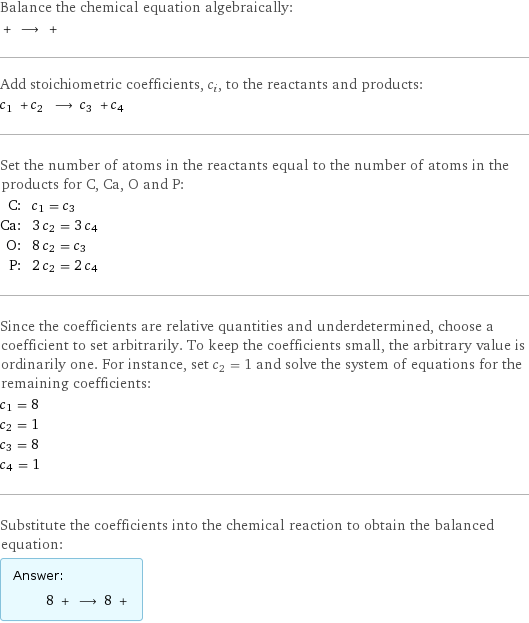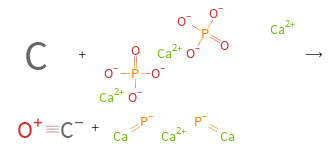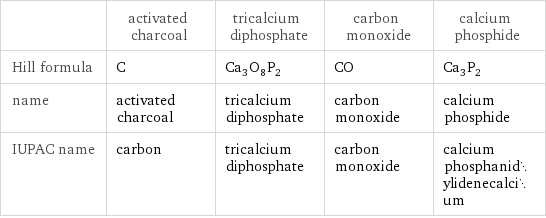Input interpretation

activated charcoal + tricalcium diphosphate ⟶ carbon monoxide + calcium phosphide
Balanced equation

Balance the chemical equation algebraically: + ⟶ + Add stoichiometric coefficients, c_i, to the reactants and products: c_1 + c_2 ⟶ c_3 + c_4 Set the number of atoms in the reactants equal to the number of atoms in the products for C, Ca, O and P: C: | c_1 = c_3 Ca: | 3 c_2 = 3 c_4 O: | 8 c_2 = c_3 P: | 2 c_2 = 2 c_4 Since the coefficients are relative quantities and underdetermined, choose a coefficient to set arbitrarily. To keep the coefficients small, the arbitrary value is ordinarily one. For instance, set c_2 = 1 and solve the system of equations for the remaining coefficients: c_1 = 8 c_2 = 1 c_3 = 8 c_4 = 1 Substitute the coefficients into the chemical reaction to obtain the balanced equation: Answer: | | 8 + ⟶ 8 +
Structures

+ ⟶ +
Names

activated charcoal + tricalcium diphosphate ⟶ carbon monoxide + calcium phosphide
Equilibrium constant
![K_c = ([CO]^8 [Ca3P2])/([C]^8 [Ca3(PO4)2])](../image_source/2d801f625d3ee8ae4d8acb2a9f0c514e.png)
K_c = ([CO]^8 [Ca3P2])/([C]^8 [Ca3(PO4)2])
Rate of reaction
![rate = -1/8 (Δ[C])/(Δt) = -(Δ[Ca3(PO4)2])/(Δt) = 1/8 (Δ[CO])/(Δt) = (Δ[Ca3P2])/(Δt) (assuming constant volume and no accumulation of intermediates or side products)](../image_source/ff4dcd5d7fa02c1475efa82467833931.png)
rate = -1/8 (Δ[C])/(Δt) = -(Δ[Ca3(PO4)2])/(Δt) = 1/8 (Δ[CO])/(Δt) = (Δ[Ca3P2])/(Δt) (assuming constant volume and no accumulation of intermediates or side products)
Chemical names and formulas

| activated charcoal | tricalcium diphosphate | carbon monoxide | calcium phosphide Hill formula | C | Ca_3O_8P_2 | CO | Ca_3P_2 name | activated charcoal | tricalcium diphosphate | carbon monoxide | calcium phosphide IUPAC name | carbon | tricalcium diphosphate | carbon monoxide | calcium phosphanidylidenecalcium